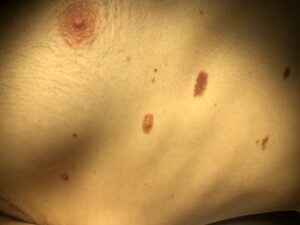 Dysplastic nevi, also known as atypical moles, are a unique type of mole that falls between common moles and melanoma on the spectrum of skin conditions. While they are benign, they exhibit characteristics similar to malignant melanomas. Although most atypical moles do not pose a health risk, it is crucial to undergo proper screening and early diagnosis to detect and treat skin cancer effectively. For all your mole-related concerns and Gainesville dermatology needs, contact The Art of Skin Dermatology
Dysplastic nevi, also known as atypical moles, are a unique type of mole that falls between common moles and melanoma on the spectrum of skin conditions. While they are benign, they exhibit characteristics similar to malignant melanomas. Although most atypical moles do not pose a health risk, it is crucial to undergo proper screening and early diagnosis to detect and treat skin cancer effectively. For all your mole-related concerns and Gainesville dermatology needs, contact The Art of Skin Dermatology
Differentiating Common Moles and Dysplastic Nevi
Common moles are skin growths that occur when pigment cells called melanocytes cluster together. The average young adult has around 10-40 moles on their body. Common moles are symmetrical, round or oval in shape, usually tan, brown, or skin-colored, and about the size of a pencil eraser. They have well-defined borders, a uniform appearance, and are commonly found on sun-exposed areas like the face, torso, arms, and legs. Having numerous moles increases the risk of developing melanoma.
Dysplastic Nevus versus Melanoma
Distinguishing between a dysplastic nevus and melanoma can be challenging to the naked eye. If a mole changes in size, shape, color, or if a new mole appears after the age of 40, individuals with dysplastic nevi are advised to consult a dermatologist. Depending on the findings, the mole may need to be removed. While it is not certain that an atypical mole will develop into melanoma, it is not uncommon for melanoma to arise within an atypical mole. Dysplastic nevi are typically asymmetrical, have irregular borders, come in various shades, are larger than a quarter inch, differ from other moles on the body, and may appear after the age of 40. They commonly occur on the back, chest, abdomen, extremities, and scalp, but can appear anywhere on the body.
Can Atypical Moles Turn into Melanoma?
Yes, although most dysplastic nevi do not progress to melanoma. The majority of atypical moles remain stable over time. However, individuals with five or more dysplastic nevi are ten times more likely to develop melanoma compared to those without atypical moles. The risk of melanoma increases with the number of dysplastic nevi and is highest in individuals with fair skin and significant freckling, indicating prolonged sun exposure without protection.
Dysplastic Nevus Syndrome (DNS)
Dysplastic nevus syndrome, also known as familial atypical multiple mole melanoma syndrome, is an inherited condition characterized by a high number of atypical moles. Individuals with this syndrome have an elevated lifetime risk of developing melanoma and require regular screenings from a dermatologist in Gainesville. Full-body photographs may be taken during screenings to monitor any changes or growth in atypical moles. Patients with DNS should also perform self-examinations between dermatology appointments.
Factors Increasing the Risk of Melanoma
Melanoma is typically influenced by a combination of genetic, environmental, and host factors. The primary environmental risk factor is unprotected exposure to UV radiation from the sun, tanning, lifetime sun exposure, or severe sunburns. Having a high number of dysplastic nevi is a significant host risk factor. Other host factors include increased freckling, poor tanning ability, fair complexion, light hair and eye color, and a family history of melanoma. Limiting sun exposure and implementing proper sun care routines are the best ways to prevent melanoma. For more information on sun protection, contact our office to speak with a Gainesville dermatologist.

 Should Dysplastic Nevi Be Removed?
Should Dysplastic Nevi Be Removed?